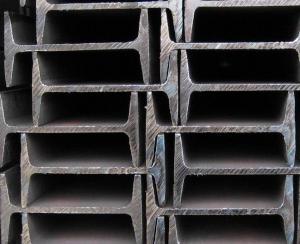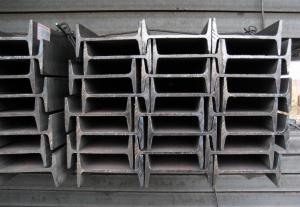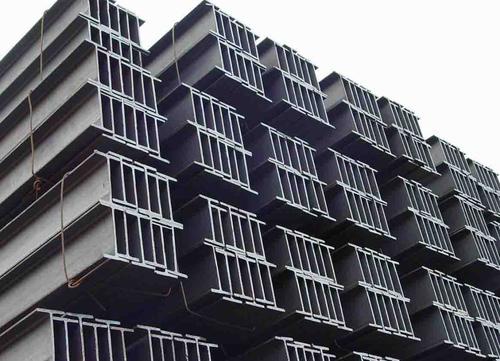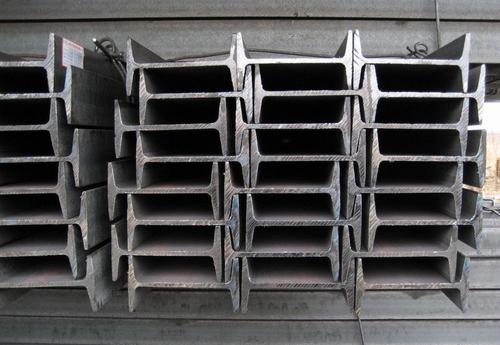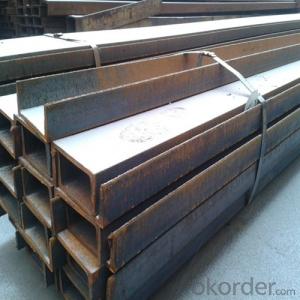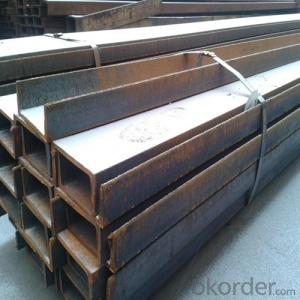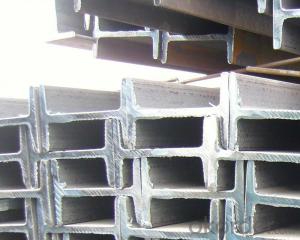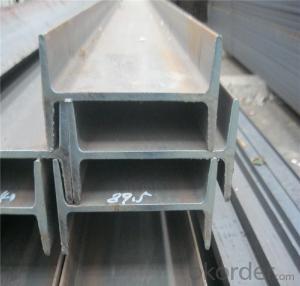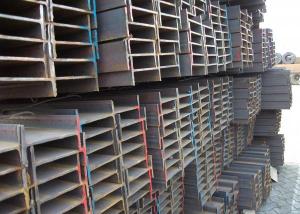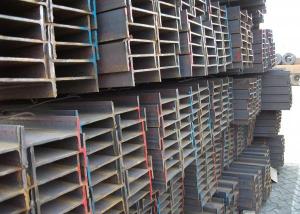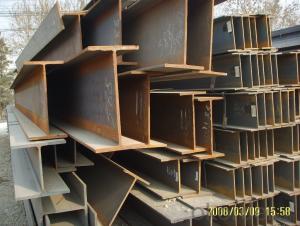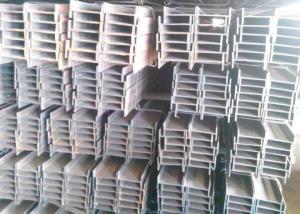IPE Beam 80mm-270mm with Material Grade GB-Q235
- Loading Port:
- Tianjin
- Payment Terms:
- TT or LC
- Min Order Qty:
- 25 m.t.
- Supply Capability:
- 10000 m.t./month
OKorder Service Pledge
OKorder Financial Service
You Might Also Like
Product Description:
OKorder is offering high quality Hot Rolled Steel I-Beams at great prices with worldwide shipping. Our supplier is a world-class manufacturer of steel, with our products utilized the world over. OKorder annually supplies products to European, North American and Asian markets. We provide quotations within 24 hours of receiving an inquiry and guarantee competitive prices.
Product Applications:
1. Supporting members, most commonly in the house raising industry to strengthen timber bears under houses. Transmission line towers, etc
2. Prefabricated structure
3. Medium scale bridges
4. It is widely used in various building structures and engineering structures such as roof beams, bridges, transmission towers, hoisting machinery and transport machinery, ships, industrial furnaces, reaction tower, container frame and warehouse etc.
Product Advantages:
OKorder's Steel I-Beams are durable, strong, and resist corrosion.
Main Product Features:
· Premium quality
· Prompt delivery & seaworthy packing (30 days after receiving deposit)
· Corrosion resistance
· Can be recycled and reused
· Mill test certification
· Professional Service
· Competitive pricing
Product Specifications:
1. Invoicing on theoretical weight or actual weight as customer request
2. Standard: EN10025, GB Standard, ASTM
3. Grade: Q235B, Q345B, SS400, ASTM A36, S235JR, S275JR
4. Length: 5.8M, 6M, 9M, 12M as following table
5. Sizes: 80mm-270mm
Dimensions(mm) | |||||
| h | b | s | t | Mass Kg/m |
IPE80 | 80 | 46 | 3.80 | 5.20 | 6.00 |
IPE100 | 100 | 55 | 4.10 | 5.70 | 8.10 |
IPE120 | 120 | 64 | 4.80 | 6.30 | 10.40 |
IPE140 | 140 | 73 | 4.70 | 6.90 | 12.90 |
IPE160 | 160 | 82 | 5.00 | 7.40 | 15.80 |
IPE180 | 180 | 91 | 5.30 | 8.00 | 18.80 |
IPE200 | 200 | 100 | 5.60 | 8.50 | 22.40 |
IPE220 | 220 | 110 | 5.90 | 9.20 | 26.20 |
IPE240 | 240 | 120 | 6.20 | 9.80 | 30.70 |
IPE270 | 270 | 135 | 6.60 | 10.20 | 36.10 |
FAQ:
Q1: Why buy Materials & Equipment from OKorder.com?
A1: All products offered byOKorder.com are carefully selected from China's most reliable manufacturing enterprises. Through its ISO certifications, OKorder.com adheres to the highest standards and a commitment to supply chain safety and customer satisfaction.
Q2: How do we guarantee the quality of our products?
A2: We have established an advanced quality management system which conducts strict quality tests at every step, from raw materials to the final product. At the same time, we provide extensive follow-up service assurances as required.
Q3: How soon can we receive the product after purchase?
A3: Within three days of placing an order, we will begin production. The specific shipping date is dependent upon international and government factors, but is typically 7 to 10 workdays.
Images:
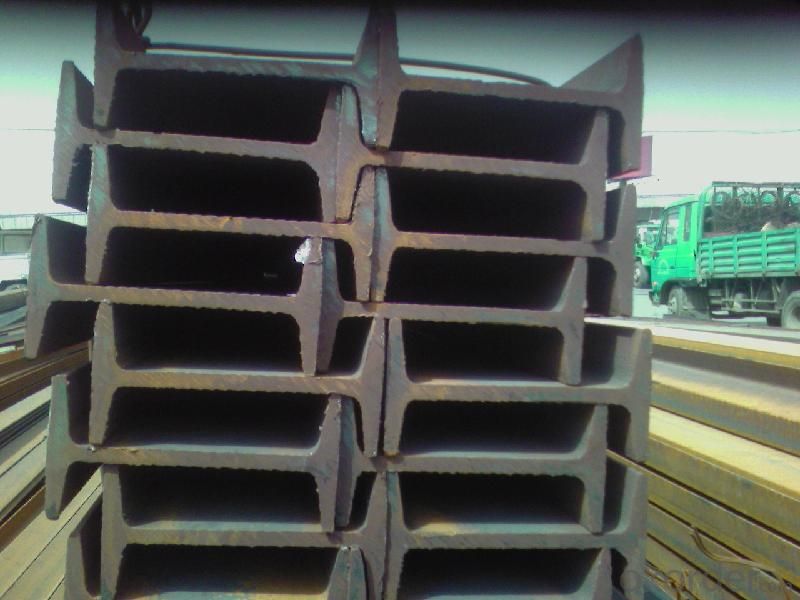
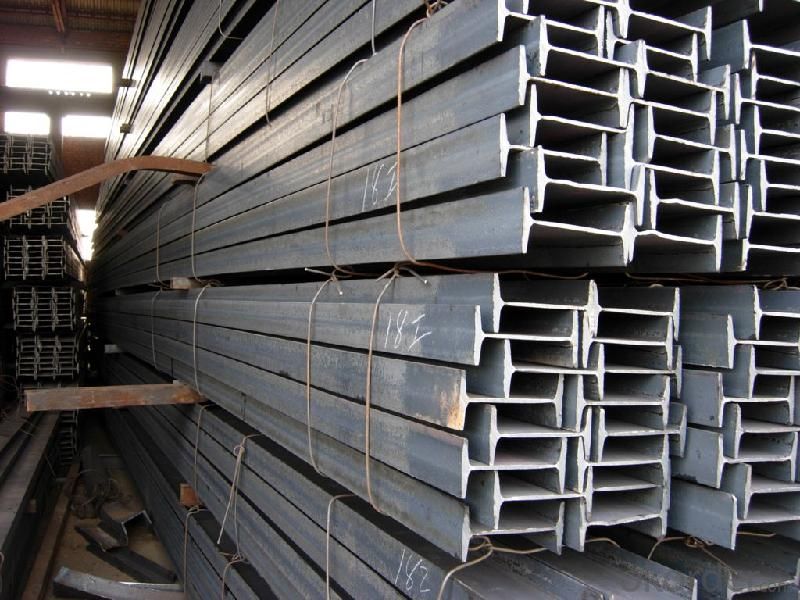
- Q: Can steel I-beams be customized or fabricated to specific lengths or dimensions?
- Yes, steel I-beams can be customized or fabricated to specific lengths or dimensions. Steel fabrication companies have the capability to cut, bend, and weld the beams to meet the required specifications. This allows for a wide range of customization options, enabling the beams to be tailored to fit specific project requirements. Whether it is for construction, infrastructure, or other applications, steel I-beams can be fabricated to precise lengths and dimensions to ensure optimal performance and structural integrity.
- Q: What are the different types of steel I-beam connections for mezzanine floors?
- There are several different types of steel I-beam connections that are commonly used in mezzanine floor construction. These connections are designed to provide structural stability and ensure the safety of the mezzanine floor. Some of the most commonly used types of steel I-beam connections for mezzanine floors include: 1. Bolted Connections: This is one of the most common and widely used types of connections. It involves using bolts to connect the steel I-beams together. Bolted connections provide a strong and reliable connection and can be easily disassembled if necessary. 2. Welded Connections: Welding is another popular method of connecting steel I-beams. In this type of connection, the steel beams are welded together to create a solid and permanent joint. Welded connections offer excellent strength and rigidity, but they require skilled labor and specialized equipment. 3. Cleat Connections: Cleat connections involve using steel plates, known as cleats, to connect the I-beams. The cleats are bolted or welded to the beams, providing a secure connection. Cleat connections are often used when there is limited access to the underside of the mezzanine floor. 4. Moment Connections: Moment connections are designed to provide resistance against bending moments and shear forces. These connections are typically used in situations where the mezzanine floor is subjected to heavy loads or dynamic forces. Moment connections involve welding or bolting additional plates or brackets to the I-beams to enhance their structural performance. 5. Bracket Connections: Bracket connections are commonly used to connect the mezzanine floor to the existing building structure. These connections involve using specialized brackets that are bolted or welded to both the steel beams and the supporting structure. Bracket connections provide stability and help distribute the load evenly. It is important to consult with a structural engineer or a professional mezzanine floor installer to determine the most appropriate type of steel I-beam connection for your specific project. They will consider factors such as load requirements, building codes, and safety regulations to ensure the proper selection and installation of the connection method.
- Q: How do steel I-beams perform in terms of sustainability and recyclability?
- Steel I-beams are materials that are highly sustainable and recyclable. When it comes to sustainability, construction projects often prefer steel I-beams because of their durability and long lifespan. They can withstand heavy loads and resist deformation, meaning they require less maintenance and replacement as time goes on. This reduces the need for additional resources and energy consumption for repairs or replacements, making them a sustainable option. Moreover, steel I-beams have a lower carbon footprint compared to other building materials. Steel is made from iron ore, which is one of the most abundant resources on Earth, and it can be manufactured using energy-efficient processes. Additionally, steel is highly energy-efficient when used in buildings, as it can help regulate temperature and reduce the need for excessive heating or cooling. Recyclability is another significant aspect of steel I-beams. Steel is one of the few materials that can be recycled indefinitely without losing its quality or strength. At the end of a building's life cycle, steel I-beams can be easily salvaged, melted down, and reprocessed to create new steel products. This reduces the demand for new materials, conserves energy, and minimizes waste sent to landfills. The recyclability of steel I-beams also contributes to the circular economy, where materials are continuously reused instead of being thrown away. This not only reduces the environmental impact but also saves costs associated with extracting and producing new materials. To sum up, steel I-beams are highly sustainable and recyclable. Their durability, low carbon footprint, and ability to be recycled indefinitely make them an environmentally responsible choice for construction projects. By choosing steel I-beams, we can contribute to a more sustainable and circular economy.
- Q: Can steel I-beams be used in multi-story buildings?
- Yes, steel I-beams are commonly used in multi-story buildings due to their high strength-to-weight ratio, rigidity, and versatility in supporting heavy loads. They provide structural support and stability, making them a preferred choice for constructing tall buildings that require a robust framework.
- Q: Can steel I-beams be used for retail store constructions?
- Yes, steel I-beams can be used for retail store constructions. Steel I-beams are commonly used in commercial and industrial buildings due to their strength and durability. They provide structural support and can handle heavy loads, making them suitable for retail store constructions that may require large open spaces and high ceilings. Additionally, steel I-beams offer flexibility in design and can be easily integrated with other building materials.
- Q: How do steel I-beams compare to other types of structural beams?
- Steel I-beams are widely regarded as one of the most versatile and efficient types of structural beams. Compared to other beams, such as wooden beams or concrete beams, steel I-beams offer several advantages. Firstly, steel I-beams have a high strength-to-weight ratio. This means that they can support heavy loads while remaining relatively lightweight. This makes them ideal for use in large-scale construction projects, such as skyscrapers or bridges, where the weight of the structure needs to be minimized without compromising on strength. Secondly, steel I-beams have excellent durability and structural integrity. Steel is a highly durable material that can withstand extreme weather conditions, including high winds, earthquakes, and heavy snow loads. It also has a long lifespan and requires minimal maintenance, making it a cost-effective choice in the long run. Another advantage of steel I-beams is their flexibility and adaptability. They can be easily fabricated and customized to suit specific design requirements. Steel can be cut, shaped, and welded into various lengths and shapes, allowing for greater design flexibility. This makes it possible to create complex structures and achieve unique architectural designs. Furthermore, steel I-beams offer superior fire resistance compared to other beams. Steel is non-combustible and does not contribute to the spread of fire. This makes it a safer choice for buildings and structures, especially in areas with strict fire safety regulations. Lastly, steel I-beams are environmentally friendly. Steel is a recyclable material, which means that it can be reused or repurposed at the end of its life cycle. Recycling steel helps to conserve natural resources and reduce carbon emissions associated with the production of new steel. In conclusion, steel I-beams have several advantages over other types of structural beams. They offer high strength-to-weight ratio, durability, flexibility, fire resistance, and environmental sustainability. These qualities make steel I-beams a popular choice in the construction industry for a wide range of applications.
- Q: Are steel I-beams suitable for multi-story buildings?
- Indeed, multi-story buildings can be adequately supported by steel I-beams. Their strength, durability, and capacity to bear heavy loads make them a prevalent choice in the construction industry. Steel I-beams offer structural support and stability, enabling the creation of multiple floors and the ability to withstand substantial weights. Moreover, these beams can be effortlessly fabricated and tailored to fulfill the precise demands and specifications of multi-story buildings. The widespread availability and versatility of steel I-beams further contribute to their popularity in the construction of high-rise buildings and other multi-story edifices.
- Q: Can steel I-beams be used for stadiums and arenas?
- Certainly, stadiums and arenas can indeed utilize steel I-beams for their construction. In fact, these beams are widely embraced in the construction industry due to their exceptional durability and strength. Their ability to bear heavy loads and span long distances makes them highly suitable for large-scale structures such as stadiums and arenas. The utilization of steel I-beams in the construction of stadiums and arenas offers numerous advantages. Firstly, their strength-to-weight ratio is remarkably high, allowing them to support heavy loads while being relatively lightweight. As a result, expansive and open spaces can be constructed without the need for excessive support columns or walls, providing unobstructed views for the audience. Moreover, steel I-beams demonstrate remarkable resistance to fire, corrosion, and pests, ensuring the long-term structural integrity of the stadium or arena. They can also endure extreme weather conditions, including strong winds and earthquakes, which is vital for ensuring the safety of spectators. Furthermore, the fabrication and assembly of steel I-beams are easily achievable, contributing to a more efficient and cost-effective construction process. They can be tailored to meet the specific design requirements of the stadium or arena, allowing for flexibility in architectural design. In conclusion, steel I-beams are an optimal choice for constructing stadiums and arenas due to their strength, durability, resistance to various elements, and versatility in design. By incorporating these beams into such structures, the safety and comfort of spectators are ensured, while providing a solid and dependable framework for these architectural masterpieces.
- Q: Is there much steel in I-beam in steel structure?
- H steel is a kind of economical cut type steel (other cold bending thin wall steel, pressed steel plate, etc.). Because of the reasonable cross-section shape, they can make steel more effective and improve the capacity of cutting. Unlike ordinary I-beam, the flange of H steel is widened, and the inner and outer surfaces are usually parallel so that it is easy to connect with high strength bolts and other components. The size of the utility model is reasonable, the model is complete, and the design is convenient for selection.
- Q: Can Steel I-Beams be used for food processing facilities?
- Yes, steel I-beams can be used for food processing facilities. Steel is a durable and strong material that can support heavy loads, making it suitable for constructing the structural framework of food processing facilities. Additionally, steel is resistant to corrosion, which is important in maintaining hygienic conditions required in such facilities.
Send your message to us
IPE Beam 80mm-270mm with Material Grade GB-Q235
- Loading Port:
- Tianjin
- Payment Terms:
- TT or LC
- Min Order Qty:
- 25 m.t.
- Supply Capability:
- 10000 m.t./month
OKorder Service Pledge
OKorder Financial Service
Similar products
Hot products
Hot Searches
Related keywords

